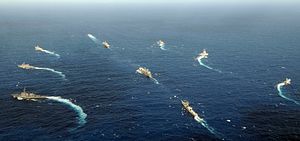On September 29, U.S. Secretary of State John Kerry hosted the foreign ministers of Japan and India for the first ever trilateral ministerial meeting on the sidelines of the United Nations General Assembly in New York.
The event was no doubt a significant development. While the United States, Japan, and India have been meeting at the assistant secretary level over the past few years, this meeting between their foreign ministers represents an official elevation of the trilateral dialogue.
For close observers of Asian security affairs, this was a long-anticipated development. Though the idea of elevating the trilateral dialogue has been discussed since 2011, the seventh iteration of the U.S.-Japan-India trilateral dialogue held in Honolulu in June was still at the assistant secretary of state level. But as I reported for The Diplomat in July, Vice President Joe Biden said in a speech at a Washington, D.C.-based think tank that Washington was “looking to schedule a ministerial level trilateral” this fall (See: “US Will Hold Elevated Trilateral Dialogue with India and Japan”).
That this has finally occurred is testament to the growing role that all three democracies – which represent a quarter of the world’s population and economic production power – have played individually in the Indo-Pacific region as well as the convergence between them. As Kerry alluded to in his remarks to reporters before the meeting, the U.S. rebalance to the Asia-Pacific under the Obama administration, India’s new Act East Policy under Prime Minister Narendra Modi, and Japan’s reinvigorated role as a ‘proactive contributor to peace’ under its premier Shinzo Abe, have all been powerful indicators of the importance these players attach to the region (See for instance: “Modi Unveils India’s ‘Act East Policy’ to ASEAN in Myanmar”). All three legs of the triangle have also been strengthened recently, with positive momentum seen in U.S.-India, U.S.-Japan and India-Japan ties over the past year (See for instance: “Modi in Japan: Great Expectations”).
The ministerial meeting itself also provided a venue for all sides to make advances on a range of important security, economic and diplomatic issues. On maritime security, it is worth noting that all three countries have already stepped up efforts to boost the capacity of individual Southeast Asian states to tackle various challenges, including China’s growing assertiveness (See for instance: “Japan Gifts Vietnam Patrol Vessel Amid South China Sea Tensions”).
But the big-ticket agenda item, as I have written previously, is Japan’s already confirmed participation in this year’s iteration of the MALABAR exercise, originally a U.S.-India bilateral exercise, which the meeting noted (See: “Japan to Join US, India in Military Exercises This Year”). The key thing to watch moving forward is whether this multilateralization can somehow be made permanent, as some U.S. officials have been calling for (See: US Official Calls for Permanent Expansion of Malabar Exercises with India”). Aside from this, the three countries also agreed to convene an experts-level group on humanitarian assistance and disaster relief to enhance capabilities to respond jointly to complex disasters.
On economic issues, cooperation is a bit more challenging. India is the odd one out among the three economically, with it still not being a member of the Asia-Pacific Economic Cooperation (APEC) forum and far from eligible for membership in the still-to-be-concluded Trans-Pacific Partnership (TPP) (See: “Finishing the TPP: It’s Not Just About the US Congress”).
However, the meeting did at least attempt to make progress in spite of this. The three ministers launched an expert-level group to identify collaborative efforts on regional connectivity, a critical issue within regional economic integration in general and for ASEAN in particular. Trilateral cooperation on women’s skill enhancement and economic empowerment will also be explored. And to add to the buzz we have been hearing over the past few months about a stronger push for India’s admission into APEC, both Modi as well as his foreign minister Sushma Swaraj mentioned this in the context of the trilateral.
Diplomatically, all three countries are members of the East Asia Summit (EAS), dialogue partners of ASEAN, and interested parties in the resolution of the South China Sea dispute. Little surprise, then, that public statements noted that all three had once again noted the centrality of ASEAN and underscored the importance of international law, freedom of navigation and overflight, and the peaceful settlement of disputes.
As I have noted before, there has been talk about Japan in particular becoming more involved in the South China Sea (See: “US-Japan Joint Patrols in the South China Sea?”). But as for the shaping of the regional architecture, including the further institutionalization of the EAS — some desire to cement its place as the premier leaders’ forum for strategic dialogue — the specifics of that will be revealed in November when the meeting is held under Malaysia’s chairmanship (See: “What Did the 26th ASEAN Summit Achieve?”).
Of course, with this being the first trilateral ministerial meeting, there will be worries about whether the momentum can be sustained through next year and beyond. But as Japanese Foreign Minister Fumio Kishida noted in his remarks, changes within the region are driving the advent of a new era that make the Indo-Pacific “the epicenter of global prosperity.” For now, it is difficult to see the three Asia-Pacific giants shying away from shaping this epicenter both individually and collectively.
































